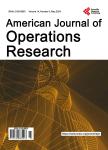Mapping What They Know: Concept Maps as an Effective Tool for Assessing Students’ Systems Thinking
Mapping What They Know: Concept Maps as an Effective Tool for Assessing Students’ Systems Thinking作者机构:Department of Science and Technology Education Ben Gurion University of the Negev Beer Sheva Israel
出 版 物:《American Journal of Operations Research》 (美国运筹学期刊(英文))
年 卷 期:2013年第3卷第1期
页 面:245-258页
学科分类:1002[医学-临床医学] 100214[医学-肿瘤学] 10[医学]
主 题:Human Body System Systems Thinking Concept Map
摘 要:In 2006 anew biology curriculum called “Human Biology: Emphasizing the Role of Homeostasis was introduced into the Israeli high school system. Complex systems like those that make up the human body have become increasingly important as a focus of high school education. This study examines the effectiveness of the concept map as a assessment tool for students’ systems thinking, a tool that provides researchers with a detailed picture of the systems thinking development taking place within individual students. The content of the students’ concept maps was translated into information about students’ system thinking using the Systems Thinking Hierarchy (STH) model, a model in which system thinking is categorized according to eight hierarchical characteristics or abilities. The goal was to use the maps to characterize Israeli high school students’ understanding of the body’s systemic nature. To do this, we identified the extent to which the students understand three central elements of systems, namely hierarchy, homeostasis, and dynamism, and then analyzed this understanding according to its place within the hierarchical stages of the STH model. The extensive qualitative data analysis of 48 concept maps made by 11th grade biology majors suggest that the strength of the concept map is in its ability to describe the first two levels of system thinking (analysis and synthesis). However, it proved less successful in eliciting evidence of the third and highest level, particularly of students’ understanding of patterns, of homeostasis and their capacity for temporal thinking.



